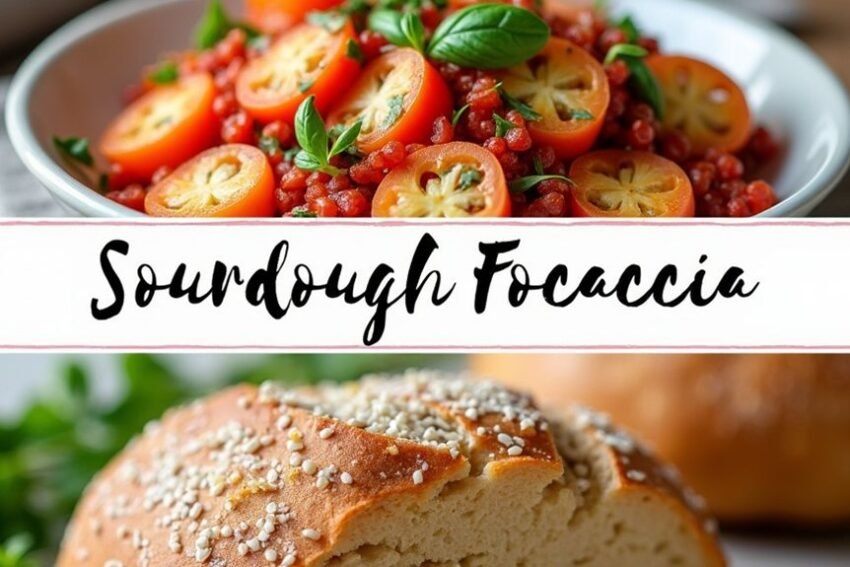Sourdough Focaccia Recipe – Crispy on the Outside, Soft Inside
Sourdough Focaccia Recipe – Crispy on the Outside, Soft Inside
Sourdough focaccia has roots that stretch back centuries, intertwining culture and culinary tradition. If you’ve ever craved a bread with a perfect contrast of crispy crust and pillowy interior, this could be your go-to recipe. The process involves intricate techniques, like using a well-fed sourdough starter and an intentional fermentation process, which raises both flavor and texture. You might wonder how to achieve that signature dimpling and what toppings work best to complement the rich taste. Let’s examine these details to reveal the secrets behind this beloved bread.
Key Takeaways
- Use an active sourdough starter and high gluten bread flour for a light, airy texture that results in a crispy exterior.
- Incorporate sufficient olive oil for added flavor and a crisp crust; consider using 30-70g for optimal results.
- Allow for a long fermentation of about 12 hours to develop deep flavors and enhance the dough’s texture.
- Utilize the stretch and fold technique during bulk rise to strengthen gluten and ensure even texture throughout the bread.
- Monitor proofing time carefully to achieve desired lightness; aim for a jiggly dough before dimpling and baking.
History
Focaccia’s origins date back over two millennia, with roots likely tracing to the Etruscans of North Central Italy or Ancient Greece. This ancient flatbread has a rich history, shaped by various cultures and practices.
Here are some key points about its evolution:
-
Early Variations: Similar flat unleavened breads appeared throughout the Middle East, Turkey, Greece, Italy, France, and Spain, highlighting a shared culinary tradition.
-
Roman Influence: The Romans spread focaccia via their empire, introducing it to France and Spain, integrating it into local gastronomic customs.
-
Baking Practices: Known as “panis focacius” or “hearth bread,” focaccia was traditionally baked in coals or on hot stones, using basic ingredients like flour, olive oil, water, yeast, and salt. Culinary traditions have continued to evolve as focaccia recipes adapted to modern tastes.
-
Regional Variations: Each region adapted focaccia, resulting in numerous forms, such as Spain’s pan de hogaza and France’s fugasse.
-
Cultural Role: In medieval times, the Catholic Church used focaccia during religious festivals, emphasizing its significance in tradition.
Over the centuries, focaccia transformed from simple bread to a cherished staple, reflecting diverse culinary practices and cultural significance across regions.
Recipe
Sourdough Focaccia Recipe
Sourdough focaccia is an exceptionally versatile and flavorful bread that can raise any meal or serve as a delicious snack on its own. Utilizing an active sourdough starter, this recipe generates a light, airy dough that’s improved by the use of olive oil, ensuring a rich flavor and a delightful texture. The fermentation process not only contributes to a distinctive sourness but also enhances the dough’s overall structure, creating a perfect canvas for a variety of toppings. The dough benefits from a long fermentation time, allowing for deep flavor development that results in a chewy and tender texture.
This recipe provides a straightforward way to create focaccia that’s crispy on the outside and soft within, making it ideal for sandwiches or to accompany soups and salads. The dimensions of the baking tray make it easy to handle, allowing you to bake a generous amount at once. Following these instructions will lead you towards producing a standout focaccia that you can enjoy fresh from the oven.
Ingredients:
– 100-115g active sourdough starter
– 400-459g water
– 500g high gluten bread flour (or a mix of all-purpose and high protein bread flour)
– 10-13g salt
– 30-70g olive oil (for topping and dimpling)
– Toppings: fresh herbs (like rosemary), sea salt, roasted garlic, tomatoes, capers, or olives (optional)
In a large mixing bowl, combine the active sourdough starter with the water, flour, and salt, mixing until there are no dry bits left. Allow the dough to rest for about 30 minutes before kneading gently to develop gluten.
Cover the bowl with a damp cloth, and let it ferment at a warm temperature (78-80°F) for about 12 hours or overnight. Once the dough has risen and is bubbly, gently spread it onto a greased 9×13 inch baking tray, dimpling the surface with your fingers, and drizzle with olive oil.
Add your desired toppings and let it proof for another 2-3 hours until it’s jiggly and puffy. Preheat your oven, then bake the focaccia for about 25 minutes or until golden brown and crispy.
When cooking focaccia, make sure to adjust the water content based on the flour’s absorptive quality, as it may differ. If you want to improve the flavors, consider adding herbs to the dough during mixing or experimenting with different toppings beyond the traditional rosemary.
Final Thoughts
When you’re ready to serve your homemade sourdough focaccia, take a moment to appreciate the process that led to its creation.
You’ve engaged in a rewarding journey of fermentation, texture, and flavor development, bringing together the elements for a delightful bread. To guarantee you achieve the best results, remember these key practices:
-
Autolyse: Allow the flour and water mix to rest for an hour. This improves hydration and overall dough texture.
-
Second Rise: Let the dough rise until it has doubled, promoting an airy structure.
-
Dimpling and Toppings: Dimpling the dough creates pockets and pressing in toppings prevents them from falling out during baking.
-
Preheated Oven: Bake at 200°C (392°F) for about 30 minutes for that golden, crispy finish. Additionally, incorporating a long, slow rise method into your preparation can greatly enhance the flavor profile.
Keep in mind the essential ingredients—active sourdough starter, bread flour, and sufficient water are critical to achieving your desired texture.
Don’t forget about storage; cooling on a wire rack prevents unwanted moisture accumulation.
With these practices in place, you can enjoy a delicious, homemade sourdough focaccia that’s truly a labor of love.
FAQ
If you have questions while making sourdough focaccia, you’re not alone! Here are some common queries along with their answers to help you achieve the finest results.
Bulk Rise: This process develops the dough’s gluten and flavor. Aim for 4 to 8 hours at room temperature for ideal results. A longer bulk rise enhances the flavor of the dough.
Stretch and Fold: Use this technique to evenly distribute yeast and build gluten, enhancing texture.
Proofing: Let the dough rest in a warm, draft-free place until it’s light and jiggly. This is essential for texture and may take several hours.
Poking and Dimpling: Dimple the dough with your fingers before baking to create holes and guarantee even spreading.
Key Ingredients: Use an active, fed sourdough starter, bread flour or unbleached all-purpose flour, room temperature water, coarse kosher or sea salt, and regular olive oil.
Common Issues:
-
Underproofing: Extend proofing time if necessary.
-
Overproofing: Monitor closely to avoid density.
-
Crispiness: Bake at 425°F, ideally on a baking stone.

